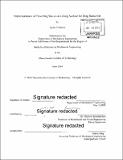| dc.contributor.advisor | Micheal Triantafyllou. | en_US |
| dc.contributor.author | V'Dovec, Taylor. | en_US |
| dc.contributor.other | Massachusetts Institute of Technology. Department of Mechanical Engineering. | en_US |
| dc.date.accessioned | 2019-12-13T18:57:48Z | |
| dc.date.available | 2019-12-13T18:57:48Z | |
| dc.date.copyright | 2019 | en_US |
| dc.date.issued | 2019 | en_US |
| dc.identifier.uri | https://hdl.handle.net/1721.1/123253 | |
| dc.description | Thesis: S.B., Massachusetts Institute of Technology, Department of Mechanical Engineering, 2019 | en_US |
| dc.description | Cataloged from PDF version of thesis. | en_US |
| dc.description | Includes bibliographical references (page 27). | en_US |
| dc.description.abstract | NACA series airfoils are the standard cross-section shapes for lift-generating surfaces widely used in both aeronautic and aquatic transportation. As with any wing, the key design goal of such airfoils is to attain a large lift-to-drag ratio, namely increasing the lift force while reducing the drag force. At moderate angles of attack, boundary layer separation begins near the trailing edge, and moves up to the leading edge as the angle increases. Such a phenomenon raises the form drag significantly, and a method of pushing the separation point back towards the trailing edge could improve the overall efficiency of the foil tremendously. One such new approach is to introduce a travelling wave on the lifting surface, a technique inspired by the undulatory motion of fish. In order to manufacture and test such a surface, first the necessary design specifications must be determined. Using NACA0012 and NACA0018 wings at a Reynolds number of 1 x 10 5, key parameters including the location of the point of separation on the wing, the angles of attack where the surface would be most effective, and the characteristics of the travelling wave itself were determined. | en_US |
| dc.description.statementofresponsibility | by Taylor V'Dovec. | en_US |
| dc.format.extent | 27 pages | en_US |
| dc.language.iso | eng | en_US |
| dc.publisher | Massachusetts Institute of Technology | en_US |
| dc.rights | MIT theses are protected by copyright. They may be viewed, downloaded, or printed from this source but further reproduction or distribution in any format is prohibited without written permission. | en_US |
| dc.rights.uri | http://dspace.mit.edu/handle/1721.1/7582 | en_US |
| dc.subject | Mechanical Engineering. | en_US |
| dc.title | Implementation of travelling waves on lifting surface for drag reduction | en_US |
| dc.type | Thesis | en_US |
| dc.description.degree | S.B. | en_US |
| dc.contributor.department | Massachusetts Institute of Technology. Department of Mechanical Engineering | en_US |
| dc.identifier.oclc | 1130060485 | en_US |
| dc.description.collection | S.B. Massachusetts Institute of Technology, Department of Mechanical Engineering | en_US |
| dspace.imported | 2019-12-13T18:57:47Z | en_US |
| mit.thesis.degree | Bachelor | en_US |
| mit.thesis.department | MechE | en_US |
